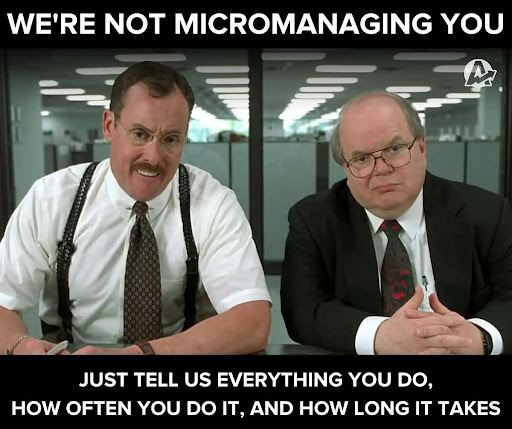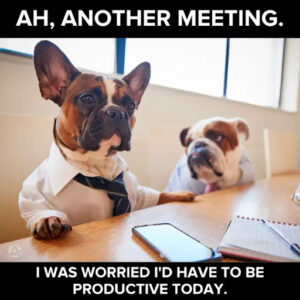The saying, “Employees don’t leave bad jobs; they leave bad bosses,” may seem trite, but it’s true.
According to recent research, “50% of Americans self-report having at some point left a job specifically to escape their boss,” and “managers account for at least 70% of the variability in team engagement levels.”
Furthermore, “employees supervised by disengaged, ineffective managers” have three times the turnover rate of workers with effective bosses and are highly likely to be disengaged themselves.1 More than 80% of workers say they would quit because of a bad manager.
Virtually no one wants to be a bad boss (and anyone who does has psychological issues and no business being in any supervisory role). But most people aren’t naturally great leaders; it’s a skill they can develop, but it takes time and effort.
If you’re a new manager or you’ve been at it for a while but are struggling, this post will help you avoid becoming (or continuing to be) a bad boss. Once you’ve mastered this, you can focus on how to become a great leader.
The Impact of Bad Bosses
As we wrote in our post on the signs and impact of bad leadership, “U.S. companies are facing a crisis of bad leadership, and it’s costing them in terms of lost employee trust, excessive turnover, and ultimately poorer business performance.”
An Inc. magazine article adds, “Bad managers can drive good employees out. Nearly seven in 10 employees say they would quit a job because of a bad manager.”2
Bad bosses have a wide range of negative impacts on their direct reports, coworkers, and their organizations, including:
- Harmful effects on employees’ mental and physical health: According to Training Industry, “overall feeling of happiness, sense of security, and perception of self…can decrease anywhere from 10% to 86% depending on the level of interaction with a bad boss.”3
- Less creativity and innovation.
- Reduced morale and productivity: “Employees with bad bosses waste between 10% and 52% of their time at work. Instead of working, they spend time withdrawing, avoiding the boss, networking for support, and ruminating about their situation.” The cost of his productivity loss is “conservatively estimated at $150,000 per boss per year.”3
Bad bosses can hinder employees’ professional development, damage the company’s reputation (on sites like Glassdoor) and culture, reduce trust and collaboration, and even increase legal costs (in cases of bullying or harassment).
Senior leaders face a train-or-terminate decision when they identify bad managers in their ranks. But good managers can also become casualties by being caught up in a purge of poor leaders or enduring the reign of bad bosses themselves.
Why Companies Have Bad Bosses
Organizations can have bad bosses in leadership roles for several reasons, including favoritism, inadequate training and development, an inability to adapt to changing workplace structures (such as remote/hybrid work), and evolving generational expectations and preferences.
However, one of the most common reasons is prematurely promoting people to management (or higher levels of leadership). High-achieving individual performers are often promoted into supervisory roles without preparation for a role requiring an entirely different skillset. Common results include:
- Lack of preparedness – Prematurely promoted managers may struggle with the new responsibilities and expectations, leading to poor performance, increased stress, and potential burnout.
- Inadequate leadership skills – Managing a team requires a different skill set than individual work. New managers may struggle to communicate effectively, delegate tasks, provide feedback, and resolve conflicts without proper training.
- Decreased morale and productivity – If employees are managed by someone who lacks the necessary skills and experience, it can result in a decline in morale, job satisfaction, and overall productivity.4
Among common mistakes made by bad bosses are:
- Lack of support and guidance for employees;
- Inconsistent/unfair enforcement of policies;
- Poor delegation skills;
- Micromanagement; and
- Favoritism and lack of fairness.4
70% of employees say their boss “has a great effect on their level of happiness, motivation, productivity, and engagement.”4
10 Ways to Avoid Being a Bad Boss
As noted in our post on the impact of and cure for bad leadership (and many other places), employees don’t leave companies, they leave bad bosses. To become a great leader, you must first avoid being a bad boss.
Here are 10 behaviors to stay away from.
1. Helicopter Management

This is the modern form of micromanagement. It damages employee morale, engagement, productivity, and ultimately retention.
Avoid “micromanaging like it’s an Olympic sport. Hovering over your team isn’t leadership; it’s nagging. Always trust [employees] to do their job. You’re a manager, not a helicopter.”5
“One specific way managers unknowingly harm team morale is through micromanagement. We noticed a roughly 20% drop in employee satisfaction scores and a decline in on-time project delivery whenever team leads checked every minor detail.”6
Helicopter management can be a technology as well as a behavioral problem for managers:
“Burned-out workers have a new problem to deal with: helicopter managers. The label applies to managers who use a raft of surveillance and software tools to keep a microscopically close eye on the daily tasks of their workers and how they use their time. It’s behavior that’s likely to backfire on employers, though.”7
2. Showing Favoritism
Favoring some employees over others can be tempting, but that temptation should be avoided. Great leaders are inclusive, treat everyone fairly, and make decisions based on objective criteria, not emotions.
Avoid “The favorite employee trap. Giving one person all the opportunities while others are left holding the metaphorical coffee cups? That’s a fast way to lose trust. Spread the love — and the bonuses.”6
3. Saying You “Hate Meetings”

Many corporate employees believe they are required to attend too many meetings. They mean they’re pulled into too many unnecessary (“it could have been an email”) or poorly run meetings. Regardless, as a manager, you must be careful about expressing this.
“When you say, ‘I hate meetings!”, your team could be receiving a message that might be damaging your culture more than you ever realized…Whether we’re talking about Zoom meetings or in-person gatherings, we need to stop saying this. Because when we say, ‘I hate meetings’, what our teammates hear is, ‘I don’t want to spend time with these people.’
“Really. Think about it. If you overhear your team leader look at their appointment calendar and say, ‘What? Another meeting with the team? Why do I have to always meet with these people?’ you could easily translate that ranting into, ‘I just don’t like spending time with them.’”8
Instead of ranting, attend courses like our Meeting Management Workshop and Presentation Skills Training. These will teach you how to ensure your Zoom or in-person gatherings maximize the cumulative energy, commitment, and talents of all those involved to meet important goals and how to communicate more effectively to a group.
4. Ignoring Problems
As the Stuart Smalley character from Saturday Night Live used to say, “Denial ain’t just a river in Egypt.” If someone on your team isn’t pulling their weight or other problems are hanging over the group, you need to have the difficult conversation or resolve the issue. Ignoring problems won’t make them disappear, but it will negatively impact your team’s morale and performance.
5. Overworking Employees
Carefully managing workloads is a great leader’s best practice. Overloading employees is the flip side of that. While there may be times that everyone needs to put in more effort to meet a crucial deadline, such situations should be the exception, not the norm.
Overworking employees leads to burnout, increased absenteeism, and ultimately decreases productivity; work/life balance matters.
6. Failing to Address Conflicts or Toxic Behaviors
Disagreements in the workplace are inevitable. But mishandling them (or failing to address them at all) can turn what could be minor speed bumps on the road to team success into destructive collisions of ego and personalities.
Professional development workshops, such as Conflict Resolution Training and Emotional Intelligence Training, teach participants how to manage emotions and use proven methods to handle disagreements and discord respectfully and professionally.
Toxic behaviors, on the other hand, are not inevitable and never acceptable. Depending upon the nature and seriousness of the behavior, it may result in immediate termination. For less serious offenses, workshops like those above can help managers effectively communicate why and how behaviors need to change.
In addition, personality assessment programs such as our DiSC Workshop and Myers-Briggs Type Indicator (MBTI) Training help managers and team members better understand their personality type and communication style as well as those of coworkers, helping team members communicate more effectively, eliminate bad habits, and minimize conflict.
7. Failing to Prioritize / Making Everything Urgent
When everything is urgent, nothing is. Employees don’t know where to focus their efforts, leading to confusion and wheel-spinning.
“One of the most damaging yet unconscious behaviors is what I call ‘selective urgency’—treating every task as equally critical and urgent, which inevitably burns out teams and dilutes genuine priorities. This often manifests when managers forward emails late at night with a simple, ‘Please handle,’ or constantly interrupt focused work with ‘quick requests’ that could wait.”6
8. Constantly Shifting Priorities
Just as bad as prioritizing everything is constantly changing what’s urgent.
“When employees work hard on initiatives only to see them abandoned without explanation, they lose motivation, and chaos quickly follows. Change is inevitable, but whiplash isn’t. Employees who don’t see the logic behind shifts disengage and lose meaning. Employees don’t need all the details, but they do need to understand why changes are happening.”9
And, “Constantly moving the goalpost is a surefire way to drain team morale. While fresh ideas may seem exciting and innovative to managers, they can unintentionally undermine the hard work and dedication employees have already invested in previous initiatives…This pattern can erode trust in leadership and create a culture where employees hesitate to invest in future projects. To prevent this, leaders should establish clear goals upfront and stick to them, barring extraordinary circumstances. If changes are unavoidable, communicate openly about the reasons behind the shift.”6
9. Lacking Empathy and Emotional Intelligence
“Bad managers may show a lack of empathy towards their employees’ challenges, personal circumstances, or emotions. They may not take the time to understand their team members’ perspectives or provide support during difficult times.”4
Emotional intelligence is vital to high-performing teams. A lack of empathy and emotional intelligence harms workplace relationships and employee well-being. Again, emotional intelligence training and personality assessment workshops can help as long as you, as a leader, are committed to improving and unlearning the behaviors of a bad boss.
10. Breaking Promises
Trust is vital to being a great leader. It takes years to build but only moments to destroy. Once you lose trust, whether due to breaking a promise or some other failure, it’s very difficult to rebuild.
“Operations managers frequently tell employees, ‘If you work hard, you’ll get promoted.’ Unfortunately, the promise is easily forgotten, giving opportunities to external new hires. Over time, employees stop trusting leadership and performance plummets. Broken promises destroy credibility and negatively affect engagement. Disengaged employees cost companies up to $550 billion per year. “9
Instead, “Let your word be golden.”9 Make a note on your calendar anytime you make a promise. Follow up with the individual once the promise is kept to close the loop. If circumstances change and you aren’t able to deliver, be transparent and explain exactly why.
Final Thoughts on How to Avoid Being a Bad Boss
Bad bosses cause many problems, from employee disengagement and reduced productivity to less innovation, lower profitability, and higher turnover. They let conflicts simmer, are poor communicators, fail to delegate effectively, and don’t support or help develop their employees.
The most common cause of bad bosses is when people who are high performers as individual contributors are thrust into management roles without preparation for a new job description.
While some individuals simply aren’t cut out for management, the good news is that in most cases, bad bosses aspire to be good bosses – even great leaders – they just need the proper training, coaching, and mentoring to get there.
To avoid being a bad boss, resisting the temptation to micromanage employees is at the top of the list. Ignoring problems, breaking promises, and failing to prioritize are among the “worst practices” to avoid.
Interested in finding out more about how team building and professional development programs can help improve decision-making, leadership, communication, and problem-solving skills across your organization? Contact Best Corporate Events to discuss program options, including customizing activities to meet your specific goals.
Sources:
- “People don’t leave companies, they leave managers—are they leaving yours?,” Redline Group Ltd. https://www.redlinegroup.com/insight-details/people-dont-leave-companies-they-leave-managers-are-they-leaving-yours
- “Managers Can Have a Huge Positive Influence on Employees—Here’s How to Make the Most of It,” Inc. Magazine. https://www.inc.com/emilymccraryruizesparza/managers-positive-influence-employees-gallup/91167274
- “Measuring the Impact of a Bad Boss,” Training Industry. https://trainingindustry.com/magazine/jul-aug-2020/measuring-the-impact-of-a-bad-boss/
- “The Impact of Bad Bosses and the Critical Role of Managers,” LinkedIn. https://www.linkedin.com/pulse/impact-bad-bosses-critical-role-managers-sonia-mcdonald/
- “Six Tips for Becoming a Better Manager in 2025 – and Six Mistakes to Avoid,” The Business Journals. https://www.bizjournals.com/tampabay/news/2025/01/14/tips-better-manager-burnout-micromanage.html?utm_source=bestcorporateevents
- “10 Ways Managers Accidentally Destroy Team Morale,” Fast Company. https://www.fastcompany.com/91272588/10-ways-managers-accidentally-destroy-team-morale
- “Rise of ‘Helicopter Managers’ Fuels Task Masking by Burned Out Workers,” The Business Journals. https://www.bizjournals.com/tampabay/news/2025/03/24/task-masking-helicopter-manager-monitor-burnout.html?utm_source=bestcorporateevents
- “Stop the Meeting Hate – Build a Healthier, More Productive Team,” Scott Cochrane. https://scottcochrane.com/index.php/2025/03/31/stop-the-meeting-hate-build-a-healthier-more-productive-team/
- “4 Things Your Employees Won’t Tell You,” SmartBrief. https://www.smartbrief.com/original/4-things-your-employees-wont-tell-you?utm_source=bestcorporateevents


